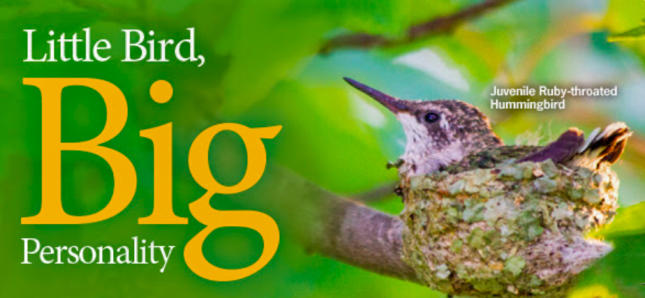Kevin's Corner

Hummingbird High Season is Here!
Here's my Late Summer Hummingbird "Pep Talk"
Its easy to get discouraged at times with hummingbird feeding in Spring & Early Summer. Its often "hit or miss" with the feeder activity. We often hear: "Where are the Hummers?" I see one or two, but there don't seem to be as many this year!" "What gives?" Well, "Buckle up Buttercup!" because they're ready to feed!
Remember- Ruby Throated Hummingbirds only nest in our region. When they first arrive in Spring they're returning from a migration to Central America & back (they don't all make it)! Their Numbers are at absolute "low point" when they arrive in the spring (fewer birds, lots of blooming flowers = light feeder activity).
Their population "peak" comes by the end of Summer. Each female may have as many as 3 broods of young (2 young per brood). Using my 4th grad math skills that translates to as many as 6 new birds per female! By late Summer, the young are mostly grown and out of the nest which means the "HIGH POINT" of the season is upon us! Expect peak activity well into September as the hummingbirds will hit the feeders hard so they can "fatten up" before migration.
Here's our best advice on Hummingbird feeding-
1- Control what you can (the rest is up to the birds).
2- Keep your feeder clean (many are dishwasher safe for top rack)
3- Keep your nectar fresh (Change every 3-4 days w/ plain sugar water nectar. Change Every 2 Weeks IF using a Nectar Defender product (ask us about it in-store).
4- Hummingbirds like to have perching points nearby (trees, bushes, etc).
5- Either set up clusters of feeder 3-5+ OR Spread out feeders (opposite sides of the house) to discourage fighting. There will ALWAYS be some bird drama. Its ok.
6- For "extra encouragement"- Add a Mister device in your yard or on a bird bath. Hummingbirds LOVE flying through misting water. (Ask us about them in-store).
Hummingbird Dont's-
1- No Dyes.
2- Stick to a 4 part water, 1 part sugar concentration (20%). (hydration is as important as the sugar content. Extra sugar does NOT give them a "boost.")
3- Don't worry about keeping your feeder up too long. They won't "forget to migrate." As long as you're seeing birds, keep your feeder up (well into October).
Troubleshooting-
1- Ants- Use an "Ant Moat," and/or "Nectar Fortress" (ask us about it in-store).
2- Bee's- Feeders with yellow colors in the design draw more bees. Leaking/Dripping Nectar does the same. Replace your feeder with an all red design (like our high perch design). You can also add "bee guard" plugs to our feeders if needed.
3-If Squirrels or other critters become interested in your nectar, You can use a "baffled pole." We also have Window Suction cup "hangers" that hold up to 5lbs. In most cases, squirrels can't get to a well placed window mounted feeder.
4-Mold/Fermentation. Change nectar every 3-4 days OR: USE NECTAR DEFENDER products!!! Nectar Defender is a natural preservative that can be added to sugar water and keeps nectar good for up to 2 weeks!!
5- If other problems come up, come on in and talk to us! That's what were here for!
General info on Hummingbirds
For such a little bird, hummingbirds can be very feisty and aggressive when defending their territories; which includes nectar feeders. Multiple feeders, spread throughout your yard, will encourage more hummingbirds to visit and keep bullies at bay. The more feeders you offer and the more spread out they are, the more difficult it is for a protective hummingbird to defend all the feeders. Others, like females or even juveniles, will be able to eat more often, perhaps staying longer to feed or rest at feeders.
Speaking of feeders, these little birds have big appetites. Hummingbirds eat about every ten minutes and, "No" their diet is not made up entirely of nectar! They spend more than 25% of their time foraging for small spiders and insects to obtain essential amino acids and other nutrients.
Hummingbirds are deceptively fast. They often seem to explode away from a feeder like a dragster. They typically fly at 30-45 miles per hour (48-72 kph), but can fly up to 60 mph (96 kph)!!! They can even hover and are the only birds able to regularly fly backwards and even occasionally upside down. They can do this because of an extremely mobile shoulder joint.
Kevin @ WBU Williamsburg

